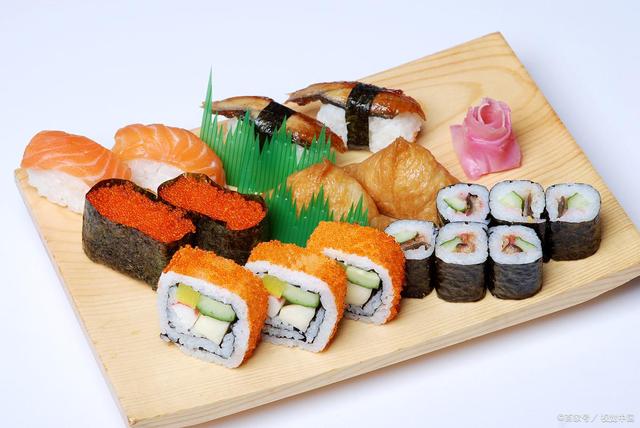
Sushi is a traditional Japanese dish consisting of vinegared rice combined with various ingredients, most commonly raw or cooked seafood, vegetables, and sometimes tropical fruits. The word “sushi” refers to the seasoned rice, which is the base for different types of sushi preparations.
There are several types of sushi, some of which include:
- Nigiri: A type of sushi featuring a small, hand-pressed mound of vinegared rice topped with a slice of raw or cooked fish, seafood, or other ingredients.
- Sashimi: Although not technically sushi since it doesn’t include rice, sashimi is often served alongside sushi. It consists of thin slices of raw fish or seafood served without rice.
- Maki: Also known as sushi rolls, maki consists of vinegared rice, fish, seafood, or vegetables rolled inside a sheet of nori (seaweed) and then cut into bite-sized pieces.
- Uramaki: A variation of maki rolls where the rice is on the outside and the nori is inside, surrounding the filling.
- Temaki: A hand roll made by wrapping a cone-shaped piece of nori around vinegared rice and various ingredients like fish, seafood, and vegetables.
- Gunkan: A small, oval-shaped mound of vinegared rice wrapped with a strip of nori and topped with ingredients like fish roe, sea urchin, or chopped seafood.
Traditionally, sushi is prepared using the following steps:
- Preparing sushi rice: Short-grain Japanese rice is cooked and then mixed with a combination of rice vinegar, sugar, and salt while still warm. The rice is then cooled and fanned to achieve the desired sticky texture.
- Preparing ingredients: Fresh, high-quality fish and seafood are essential for sushi, and they are typically sliced or prepared according to the type of sushi being made. Vegetables and other ingredients are also prepped for use in sushi rolls or as toppings.
- Assembling sushi: Depending on the type of sushi, ingredients are either combined with the vinegared rice or used as a topping, filling, or wrapping. For example, nigiri is made by hand-pressing rice and placing a topping on it, while maki rolls are made using a bamboo sushi mat to roll rice and ingredients together inside a sheet of nori.
- Serving sushi: Sushi is usually served with soy sauce for dipping, as well as small amounts of wasabi (a pungent green Japanese horseradish) and pickled ginger (called “gari”) to cleanse the palate between bites.
Sushi is a delicacy in Japan and has gained worldwide popularity for its unique combination of flavors, textures, and artful presentation.